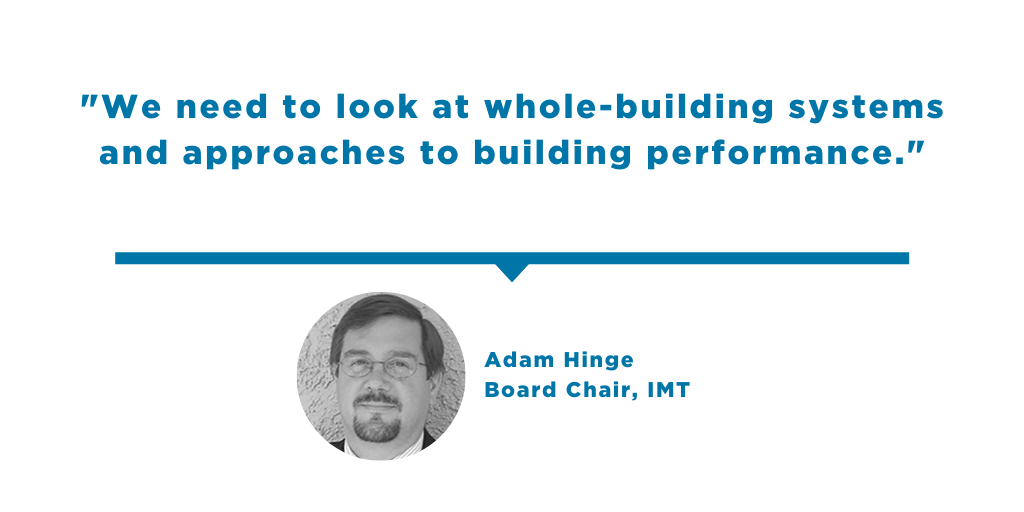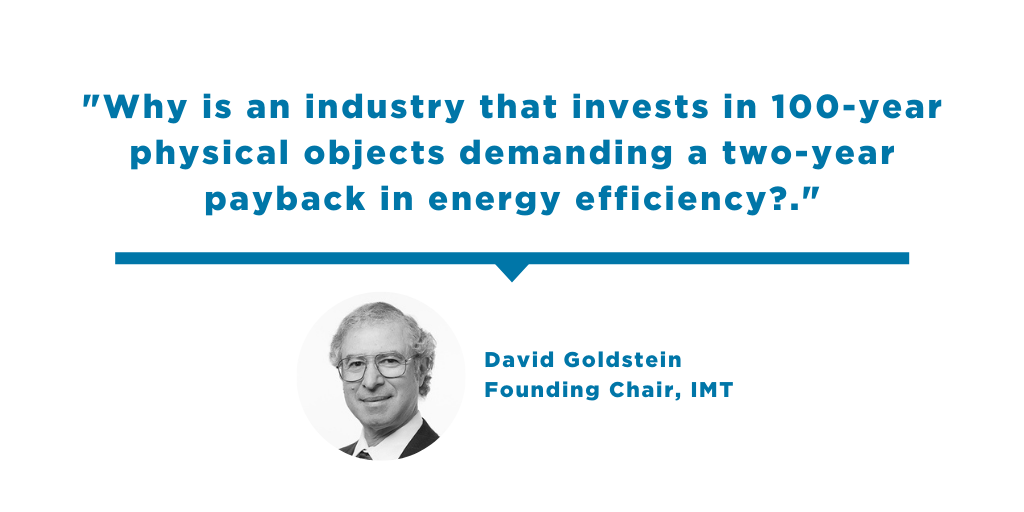The start of a new year provides a chance to reflect on where we’ve been before we turn to the fresh slate ahead. This year also marks the 25th anniversary of IMT’s founding. We’re beginning 2021 with an interview of David Goldstein, our founding board chair, and Adam Hinge, our current board chair.
Looking back at where we’ve been, David, at a high level, what spurred you to start IMT?
David Goldstein:
Market transformation was a new concept 25 years ago. At the time, we were under the mistaken impression that market failures weren’t the main issue. But even by then we had learned that real markets for energy efficiency do not perform the way naïve economic theory said that idealized markets do. This theory says if consumers want something, the market will automatically provide it. But if manufacturers don’t produce efficiency and vendors don’t stock it, how can consumers express a demand for efficiency? When you look at the whole structure of the business community, you discover some fairly deep market failures. Broadly speaking, IMT was set up to find ways to overcome these failures and get them implemented. We started with energy code work in Russia, which had recently emerged from being the Soviet Union and was perhaps the third biggest climate polluter at the time. It has a very cold climate and yet it was constructing new buildings with only double-pane windows, no special coatings, and without insulation in many cases. We saw the opportunity to stem climate change globally by taking lessons learned in American states, such as California, and transferring them overseas.

There was no institutional mechanism for doing that, so we created one in IMT. The energy codes in Russia are now 100% better on efficiency and energy use is 50% lower or more. That would not have happened without IMT’s support for efficiency with the Russian Ministry of Construction. And the exchange of good ideas did not just go one way: the Russians developed labeling systems for buildings that are now used in many leading states and cities in the U.S.
Adam, you’ve also long been involved in building efficiency and market transformation work. What drew you to work with IMT?
Adam Hinge:
I knew of the work David and the others were doing in Russia and some of the domestic activities IMT was tackling related to property valuation and energy efficiency. David and I first met when he was an advocate and I was a regulator with the New York State Energy Office in the mid-1980s. We stayed in touch and I joined the IMT board in 2006. IMT was doing great stuff before I got involved and I’ve been really pleased with all of the work that has gone on since I joined the board of directors.
IMT’s work is now predominantly focused in the U.S. How have U.S. market needs changed over the past 15-25 years? Where have we, as a collective industry, most made progress on breaking down market barriers to more efficient buildings?
Hinge:
There is greater awareness of the opportunities for cost savings from energy efficiency from building owners, including home owners, as a way of reducing operating costs. Over the last 15 to 25 years, utilities have become much more important, regular partners in helping customers use energy more efficiently. We have also made tremendous progress on more efficient technologies, and, over the last 10 to 15 years, there has been a lot more recognition that we need to look at whole-building systems and approaches to building performance.

IMT’s strength has been collaborating with building owners and the real estate industry, and then taking that knowledge to policymakers to drive new policies related to building performance. Thanks to that work, there’s been a major upswing in the last five to 10 years in the recognition that there are huge building performance improvement opportunities in existing buildings.
Goldstein:
Adam makes a key point. Twenty-five years ago, very few companies recognized that efficiency was good for business—even ones who were in the business of selling the supplies and services that are used for efficiency, such as insulation manufacturers. We’ve seen a gradual but very powerful movement of companies recognizing that efficiency is important to their own profitability, as is overcoming market failures. We’ve also seen the growth of corporate social responsibility as a motivator for companies. After the Trump administration exited the Paris agreement, some companies said “Well, if the government isn’t going to be active on climate change, it is on us and we’re going to adapt our own goals and policies—the whole ‘We’re Still In’ movement after the Paris agreement. I think with the new administration coming in and rejoining the Paris Agreement, and the actions business and local government have taken with IMT’s help, we have the chance for the federal government to be working in partnership with these existing efforts; we can have all the oars on the ship rowing in the same direction to move the ship rapidly in the direction we need.

This is critical because the global climate problem is more severe than we thought. The predicted effects of climate change are coming earlier and more severely than expected. The response has been the call to stop warming at 1.5 degrees Celsius, rather than 2 degrees. To understand how daunting that is, we’re already at 1 degree. IMT has been one of the first and strongest voices saying we can’t just focus on a 2050 goal of carbon neutrality; we need to look at 2030 and what we can do in existing buildings in the short term to reduce their impact.
As we kick off 2021, we’re one year into what IMT has identified as a critical decade of action for buildings. Between now and 2030, what do you see as the biggest opportunities for improving building performance? What most excites you about the 12 months ahead?
Goldstein:
I see this as a two-piece solution set. The first piece is not technical at all: we need to inspire hope. Meeting a 1.5-degree goal is daunting, but it is being portrayed as much more troublesome than it really is by opponents—particularly people with fossil fuel industry connections. We must point out yes, we can do this and no, it’s not disruptive. In fact, it creates jobs, creates prosperity, and helps enhance profitability.
The second piece is that now that we’ve recognized it’s a good thing to take action, we need to show how we do it. IMT has done that by focusing on jurisdictions that find it easier to address retrofits, which are the biggest opportunities in the short term. This is mainly local communities and business actors in the real estate sector. We’re there providing the technical and market development solutions.
Adam mentioned IMT’s work on the valuation of real estate; this is an underappreciated concept. Why is an industry that invests in 100-year physical objects demanding a two-year payback in energy efficiency? The answer is because they’ve got it in the wrong bucket, they’ve got it in the operating expense bucket when they should have it valued as an asset because it will produce cost reductions reliably over the foreseeable future. That’s an area where IMT was one of the first organizations to look into at a serious level thanks to Cliff Majersik.

Hinge:
What gets me excited about the coming year and decade are new building performance laws, which IMT has been in the middle of the developing. In the coming year or two, as leading jurisdictions move forward with their building performance policies, IMT will play an important role in working with our private sector partners to provide feedback on implementation, including innovations like green leasing. That will improve the learning and cut down on the fits and starts that might happen otherwise.
I think the other piece that I’m really excited about is understanding how we can better integrate social and economic equity into building performance standards. Going beyond the traditional energy and climate performance to address other equity areas is both exciting and a significant challenge, but I think IMT is leading some of that thinking in its city policy work. I’m looking forward to seeing how IMT continues to lead here.
Goldstein:
That’s an important point. Energy efficiency inherently helps with equity, but it doesn’t help as much if you rely on it happening by accident as it could if you actively make it a goal. In 2020 we’re now seeing a wide range of organizations recognizing we have an equity problem in the United States. IMT was already moving to address that.
One of the big shifts IMT has made is recognizing that efficiency doesn’t exist in a vacuum but is most meaningful when deployed in tandem with other strategies. Looking forward, how do you both see energy efficiency evolving in a world of low-cost renewables, energy storage, and grid-responsive buildings?
Goldstein:
This is another important issue that IMT has also been leading. We now recognize efficiency is not as simple as looking at how much energy it takes light a building or keep it warm. We also need to look at how much polluting energy it takes to make a kilowatt hour of electricity. The answer looking into the future is different if you’re talking about 10 am vs. 8 pm, as well as seasonal variations. Efficiency can now involve using the same amount of energy at the building site, but using it at the times when renewables are plentiful and avoiding it when the grid is dirtiest. IMT has been integrating that into its work with cities. This involves a lot of actors coordinating and it’s difficult, but we need to set things up so that—when the market infrastructure supports it—we can have buildings that save not just 30% energy, but 50% of emissions.
Hinge:
I would add that the pace of change in the energy sector and the electricity sector is unprecedented from what I’ve seen over the last 40 years. Both the energy industry and real estate construction industry are conservative business sectors and in some ways it can take a shock to get them to move. We’re seeing that now with wide, very fast changes in the penetrations of renewable electricity. In the northeast, we’re seeing regulators question whether to invest in new gas infrastructure that will likely become a stranded asset in 10-25 years. That’s pushing utilities and other fuel providers to find creative solutions and work with building owners to figure out how price signals and other contractual arrangements shape grid responsiveness.
Is there anything that either of you like to add as a final note?
Goldstein:
The future can provide even more opportunity to transform markets so that they encourage innovation. What Adam and I were just talking about involves setting up feedback loops within the market so that as you change to accommodate the known technologies to integrate renewables into the grid and manage demand, you open up the possibility of businesses inventing new ones and marketing them. For example, we know that charging electric vehicles is something that you can shift in time and you can even have the vehicle feed back into the grid. This is something we’ve known for 10 to 20 years, but we hadn’t thought as much about activities where you’re getting storage for free—like water heating as a very simple and virtually free opportunity for moving around the periods of electricity demand by a time clock or in response to real-time signals on the Internet of Things.
I am confident we can find a lot more automated ways to alter the time of energy use to create flexibility in demand, once we have set up the infrastructure to measure performance and incentivize doing an incrementally better job. When it becomes profitable to do these new things, companies will introduce controls and technologies that accomplish it at much lower cost.

Hinge:
The thing I’m struck by as we’ve been talking is that, thinking back 25 years, some of the things we’re talking about now were not in wide discussion. Twenty five years ago, I wouldn’t have envisioned how quickly things are happening now. I wonder what conversations we’ll have 25 years from now as we move through this period of rapid transformation.
